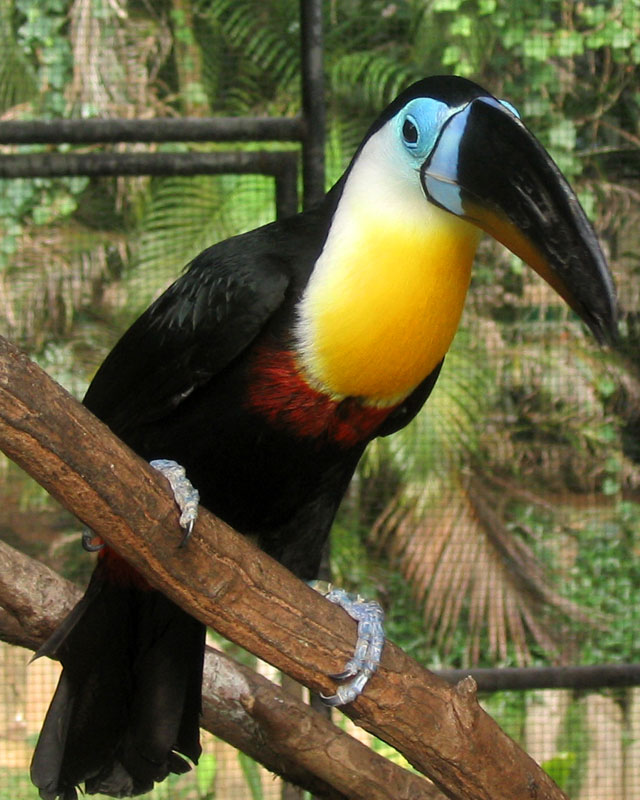|
| 질의: yellow-ridged toucan | 결과: 4번째/4 | |
Channel-billed Toucan (Ramphastos vitellinus) - Wiki
| 제목: | Channel-billed Toucan (Ramphastos vitellinus) - Wiki
| |

| 해상도: 640x800
파일크기: 116776 Bytes
등록시간: 2007:12:10 16:19:26
|
Channel-billed Toucan
From Wikipedia, the free encyclopedia
Order: Piciformes
Family: Ramphastidae
[Photo] Channel-billed Toucan (Ramphastos vitellinus vitellinus) in captivity. Photo taken in Trinidad and Tobago. Source: Flickr (www.flickr.com/photos/guerinjeanmarc/88031017/in/set-72157594234460822/). Date: January 17, 2006. Author: Jean-Marc /Jo BeLo/Jhon-John (www.flickr.com/photos/guerinjeanmarc/).
The Channel-billed Toucan (Ramphastos vitellinus) is a near-passerine bird which breeds in Trinidad and in tropical South America as far south as southern Brazil and central Bolivia.
Taxonomy
The subspecies were previously considered separate species, but all interbreed freely wherever they meet. These are the Yellow-ridged Toucan (Ramphastos culminatus; now Ramphastos vitellinus culminatus), the Citron-throated Toucan (Ramphastos citreolaemus; now Ramphastos vitellinus citreolaemus) and the Ariel Toucan (Ramphastos ariel; now Ramphastos vitellinus ariel). However, the subspecies Ramphastos vitellinus ariel is closer to Ramphastos vitellinus culminatus than to the nominate, and are by some already considered close to distinct species status. As Ramphastos vitellinus ariel was described before Ramphastos vitellinus culminatus, if separated they would become Ramphastos ariel ariel and Ramphastos ariel culminatus. There also exists an isolated population in eastern Brazil. It looks very similar to, and has traditionally been considered part of, Ramphastos vitellinus ariel, but molecular analysis suggests that it has been isolated for a long time and is a yet-undescribed separate subspecies or possibily even species (Weckstein, 2005).
Description
Like other toucans, the Channel-billed is brightly marked and has a huge bill. It is typically 48 cm (19 in) long with a 9-14 cm (3½-5½ in) bill.
Nominate race (Ramphastos vitellinus vitellinus): Its upperparts, belly, tail and most of the bill are black, and the uppertail and undertail coverts are red. The bare eye-patch and bill base are blue, the throat is white, the central breast has a large orange-yellow spot and the lower breast a broad red band. The iris is dark brownish. It is found in the north-eastern part of this species' range.
Race culminatus: It resembles the nominate, but has a yellow base of the upper mandible and ridge to its bill, orange-yellow uppertail coverts and the throat and breast are white (occasionally tinged yellow), with just a narrow red band separating the latter from the black belly. It occurs in the eastern and south-central part of this species' range. It is very similar to, and easily confused with, Cuvier's Toucan (Ramphastos tucanus cuvieri).
Race ariel: It resembles the nominate, but the base of its bill is yellow, the skin around the pale blue eye is red and the entire throat and chest are orange. It occurs in the south-east Amazon. The unnamed population from the coastal regions of eastern Brazil is virtually identical.
Race citreolaemus. It resembles culminatus, but with a clear yellow tinge to the throat, a green tinge to the othewise yellow culmen, a yellow-orange patch at the very base of the bill, and a pale bluish iris. It occurs in northern Colombia and north-western Venezuela.
Wherever the distributions of the subspecies meet, individuals with features that are intermediate compared to above described races are common due to hybridization. Some of these intermediate populations have sometimes been awarded subspecies status, e.g. theresae for the population in north-eastern Brazil and pintoi for populations in south-central Brazil (both are culminatus-ariel intergrades).
Habitat
Found in forest and woodland. Prefers humid regions, but locally extends into drier regions (esp. along rivers). Mainly in lowlands, but locally to an altitude of 1700 m (5600 ft).
Behavior
This species is an arboreal fruit-eater, but will take insects and other small prey, e.g. insects, small reptiles and eggs and nestlings of other birds. The call is a croaking cree-op cree-op cree-op.
The parents are both active in raising the young. The white eggs are laid in a high unlined tree cavity. There is have a gestation period of 18 days, and the parents both incubate for 15 to 16 days. However, they can be impatient sitters, often leaving their eggs uncovered for hours at a time. Newborn toucans remain in the nest after hatching. They are blind and naked at birth, and their eyes open after about 3 weeks. They have short bills and specialized pads on their heels to protect them from the rough floor of the nest. The feathers do not begin to expand until they are nearly 4 weeks old. They are helpless and unable to leave the nest for about 8 weeks, dependent upon both parents to feed them. After this, the young can care for themselves. They begin to leave the nest after 40 to 50 days, depending on size.
http://en.wikipedia.org/wiki/Channel-billed_Toucan
| The text in this page is based on the copyrighted Wikipedia article shown in above URL. It is used under the GNU Free Documentation License. You may redistribute it, verbatim or modified, providing that you comply with the terms of the GFDL. |
|
^o^
동물그림창고 똑똑전화 누리집
^o^
|
|